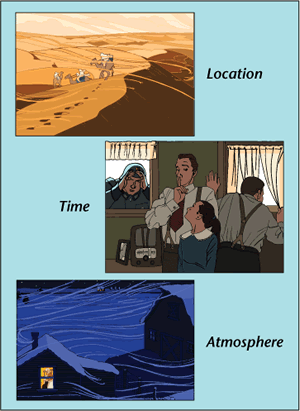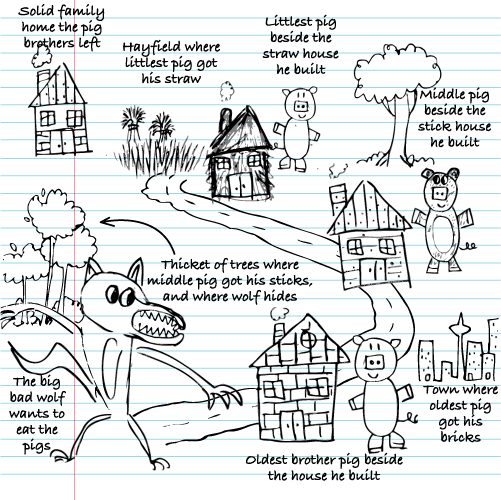Lesson 2.1B: Setting the Stage for a Good Read
 Are you an effective reader? Do you remember much of what you have read? Since it is time to start reading your novel, we are going to take a few moments to provide you with useful tips for being an effective reader. After you begin your novel, we will look at the setting: the setting is the location, place, atmosphere, as well as the circumstance of the story. Are you an effective reader? Do you remember much of what you have read? Since it is time to start reading your novel, we are going to take a few moments to provide you with useful tips for being an effective reader. After you begin your novel, we will look at the setting: the setting is the location, place, atmosphere, as well as the circumstance of the story.
Tips for Effective Reading
Have you ever read a few pages of a book or magazine and looked back to realize that you haven't absorbed a word of what you'd read?
When that happens, have you ever done the following:
- go back and try again, sometimes to miss the point a second time
- plow forward, even though you skipped big chunks of information
- find a new way to read to get the most out of the story
Discussion Prompt |
| Think about strategies you use for getting the most out of reading. What works for you? What doesn't work? |
Guidelines for contribution:
Post your contributions to the discussion. Click here to add your journal entry now. |
This lesson has a few tips to make effective readers out of even the sleepiest skimmers.
To change your skimming ways, or to brush up your reading skills, follow these tips. You'll save time later by not having to re-read, and have a superb reference to use for assignments and test preparation.
Tips for Being an Effective Reader
- Find a comfortable place to read, but not on your bed if you have a habit of falling asleep there! (TV off, computer open for notes only!)
- Have a pencil and paper, or computer, nearby and your novel.
- Keep a glass of water and a snack by your side, not a long walk away in the kitchen!
- When you first begin, wonder about the book… What kinds of things are going to happen? Does the novel remind you of any books you've read, or movies you've seen? Do any characters seem like people you've known?
- Read the opening few pages, or look back over the last few pages you read.
- Ask yourself a question or two about what you have learned so far: where do you think the story is going? Why did the last events happen? Who is involved?
- At the end of each chapter, stop and think about what you've read. Try completing "chapter notes."
Entering the World of Your Novel
It is time to pick up the novel and see what is inside. Are you familiar with the author? The title? What do you think this novel will be about? Look at the cover; read the back flap. Wonder about the book: Will there be any deaths? Any romances? Any celebrations? Now, begin reading. The reading instructions in each lesson will tell you how much to read, and how to keep chapter notes, which are optional. Students who have difficulty reading, or students who would like to have a written summary of the main events of the novel when they are finished, are encouraged to write chapter notes. They are terrific reading support.
 Please read the opening chapters of your novel: The Chrysalids, chapters 1 - 3. Please read the opening chapters of your novel: The Chrysalids, chapters 1 - 3.
|
Chapter Notes (optional)
As you read your novel, you can use chapter notes to keep track of the events that each chapter brings. They will help you to recall the story and to understand it better when you have finished reading. View the following example of "chapter notes" to see how you can organize them.
Note: Keeping notes on paper is very portable: it allows you to read and keep notes wherever you are, whether you are at home, on the bus, babysitting, or wherever. It's also easier to make additional notes on the side as you learn more about characters, or to link ideas when you are studying. |
You might use the following chart to keep chapter notes. If you like the chart, save a blank copy to your computer which you can add to and "save as" for each chapter. You can keep chapter notes on paper or print the chart onto your own paper. Keep a page for each chapter, or one for each few chapters.
Click on the rtf or doc icon to download a copy of the chart.
Setting and Situation
 Take a moment now and view Establishing a Setting. Take a moment now and view Establishing a Setting.
You've read the opening chapters of your novel. One of the first things we learn about a story is the setting. The most obvious parts of the setting are the place (where), time (when) and atmosphere in which a novel is situated. Setting also includes the human-made environment, such as the décor of the room and even the clothing of the characters. Setting gives us a lot of clues about the characters' lives and personalities.
In addition to the place and time, setting refers to the circumstances of the characters' lives: whether the characters live in wealth or struggle in poverty, if there is a war going on or if the characters live in peace, or if they are entitled to freedom while other people are not.
 The setting also includes the kinds of relationships the characters have. For example, if the main character is young and lives at home, his circumstances are different depending on whether his family is lead by a strict, unforgiving parent or a loving but over-protective parent. The situation might be that a character is miserable because she has recently lost two jobs in a row, or conversely, that the character is confident because she has recently won two medals. The setting also includes the kinds of relationships the characters have. For example, if the main character is young and lives at home, his circumstances are different depending on whether his family is lead by a strict, unforgiving parent or a loving but over-protective parent. The situation might be that a character is miserable because she has recently lost two jobs in a row, or conversely, that the character is confident because she has recently won two medals.
Let's think about "The Three Little Pigs" once again.
The setting of "The Three Little Pigs" is rural, or near a town, but it is not in a city. We know this because the pigs can get straw, sticks, and bricks as they need them. We aren't sure when the story took place, but it had to be a long time ago, when pigs roamed free and wolves were able to knock on doors (just kidding!). We can guess that the time of year is spring or summer because two of the pigs are happy to be outside and not that interested in building strong shelters.
The situation suggests that the three brother pigs get along. It seems that the pigs are teenagers or young adults, because they have to move out and find places of their own. They also appear to be fairly well off: at least there are enough resources around for them to build their houses without much struggle.
Now let's consider the first few chapters of your novel. Take a moment to answer the following questions about your novel to identify the setting and the situation.

Journal Entry 2.1B: Exploring Setting
Answer the following questions in the Journal section of the assignmetn template.
- How would you feel if you switched places with David for a week? What would you enjoy about living in his world? What would you miss about your own? Do you think you would make any changes in your life if you were him? What would you do?
- In your previous journal entry, you examined your preferred learning style. Some additional strategies that can help you understand dense pieces of text is to take notes or draw images to help anchor important details. Draw a map of the main character's environment as it has been described in the opening chapters. Include at least four significant places, and write down four significant events that have happened in the area and which involved the main character. Include also four people who have been introduced in the story so far, and label their role in relationship to the main character. Your map should be about one notebook page in size. Use any notes from reading logs to support and enhance your answer. View the following map of the "Three Little Pigs" as an example.

|
 Grammar Checkup Grammar Checkup
Go to Writing on the Run! and complete the tutorial and exercises on "Sentence Fragments.
Summary
Completing this lesson has helped you to:
- assess your efficiency as a reader, and learn new skills for more effective reading
- identify the setting and situation of your novel
- reflect on how you might handle living in the main character's environment
|

